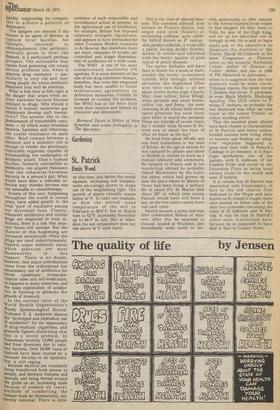Gardening
St. Patrick
Denis Wood
At this time, just before the vernal equinox, increasing soil temperatures encourage plants to make use of the lengthening light. The growth of plants virtually ceases below 41°F. To take one example, at Kew the normal mean temperature of the soil in February is 39.6°F, but in March rises to 42°F, increasing thereafter up to 64°F in July (but at Aberdeen the soil temperature does not rise above 41°F until April).
This is the time of almond blossom. The common almond, now known as Prunus dulcis, has single pale pink flowers of enchanting coldness, quite unlike the hybrid known as P. xam. ygdalo-persica pollardii, a cross with a peach, having double flowers, darker in colour and informed with the hectic quality of pink typical of peach blossom.
The earlier daffodils will have been in flower for a week or more, notably the lovely cyclamineus hybrids, with strongly reflexed perianths, like frightened fillies with their ears back — all are about twelve inches high: Charity May, clear yellow; Dove Wings, white perianth and small lemonyellow cup; and Jenny, the most charming of all, whose little crown opens primrose but soon turns pure white to match the perianth. These are hybrids of recent years, but I wonder what flowers St Patrick saw at about the time of what we know as his day?
He lived from about 385-461 and was born somewhere in the west of Britain. At the age of sixteen he was captured by pirates and taken to Slemish in Antrim to work as a manual labourer and swineherd. He escaped to France and in his wanderings abroad he probably visited Marmoutier by the Loire, the abbey which had grown up near the place where St Martin of Tours had been living a solitary life in about 371. St Martin died about 397, at which time young Patrick would have still been a boy, so the two saints cannot have met each other.
Patrick became a priest and was later consecrated Bishop of Auxerre. After this he returned to Ireland, landed at Wicklow, and immediately went north to An trim, quixotically to offer ransom to his former masters from whom he had escaped. He then went to Tara, the seat of the High King, and set up his episcopal see at Armagh in 444. He is said to have made use of the shamrock to illustrate the doctrine of the Trinity. David McClintock in his book Companion to Flowers, refers to the botanist Nathaniel Colgan, author of Flowers in County dublin, and also in 1896 of The Shamrock in Literature, where it is suggested that the true shamrock could be white clover, Trifolium repens, the lesser clover T. dubium, red clover, T. pratensis, or even Black Medick, Medicago lupulina. The OED refers to T. minus (T. dubium), so probably the real shamrock was what we now know as the Lesser Trefoil, or yellow suckling clover. That the smallest plant should have been chosen is characteristic of St Patrick and many saints, humble austere men living often as hermits and feeding on whatever vegetation happened to grow near their cells. St Patrick's Cabbage is an instance, it is Saxifraga spathularis, one of s the parents, with S. umbkrosa, of our London Pride and noted in the Excursion Flora as being local among rocks in the south and west of Ireland.
It is certain that St Patrick was associated with Glastonbury, in fact in the old church first dedicated to the Virgin and later known as St Joseph's chapel, there once existed on either side of the altar two pyramids containing the relics of St Indracht and St Patrick. It may be that St Patrick's relics were transferred here, because he is supposed to have died at Saul in County Down.


































 Previous page
Previous page